10 South Asian LGBTQ Books That Changed My Life
This summer marks eight years since I came out to myself (and subsequently, my brother) and four years since I cut my hair and came out to my dad. This time of year marks a significant shift in my life, which means every year I use it to reflect on how far I’ve come in getting comfortable with myself.
I’ve always been an avid reader, hungry for imaginary worlds I could lose myself in and fictional characters I could call best friends. Growing up, there weren’t any fictional South Asian LGBTQ role model for little old closeted me. Since my coming out, and really over the past decade, I’ve seen a sizable shift in this. While on-screen depictions may be coming forth with the web series The Other Love Story or characters like Krishna on Jane the Virgin, the written word has proven sturdier. From fiction to anthologies and histories to graphic novels, the last ten years have shown that telling our own stories is essential to building a community and garnering the strength to live an authentic life.
The best part about these works is that they aren’t just the mainstream LGBTQ narrative of coming out, even though that’s huge and important and incredibly brave. These stories are about multi-faceted people living their lives, and trying to balance culture, norms, and traditions while doing it.
In honor of my comingoutaversary, or really just owning the fact that I can be South Asian and queer and still exist, here are ten books that are written by and/or feature LGBTQ South Asians. Some of these existed when I came out and some didn’t — all have helped on the journey since.
Nights Like This by Divya Sood
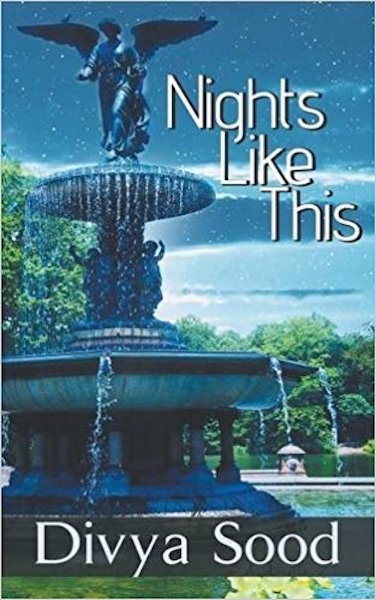
An all-too-relatable tale of dual lives, this novel is centered around Jess, a South Asian woman struggling with her desires for two women and two careers. A love story through and through, Sood manages to capture the emotional depth of the characters while also doing justice to the cultural nature of their origins. Nights Like This made me feel seen in a way that not a lot of books have — and it also managed to surprise me along the way.
Bright Lines: A Novel by Tanwi Nandini Islam
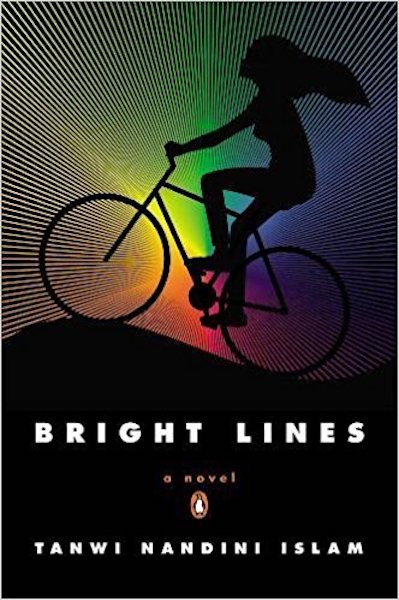
Full of heartbreak, suspense and captivating adventure, Bright Lines is the story of Ella, a woman whose journey takes her from Bangladesh to Brooklyn and then back again. Bound together by secrets, Ella’s family is a complex web of characters — one that at once grounds her and puts her at odds with who she is. Against the backdrop of Ella’s sexuality, Islam portrays a world that engrosses the reader and questions what we know about our own pasts.
She of the Mountains by Vivek Shraya
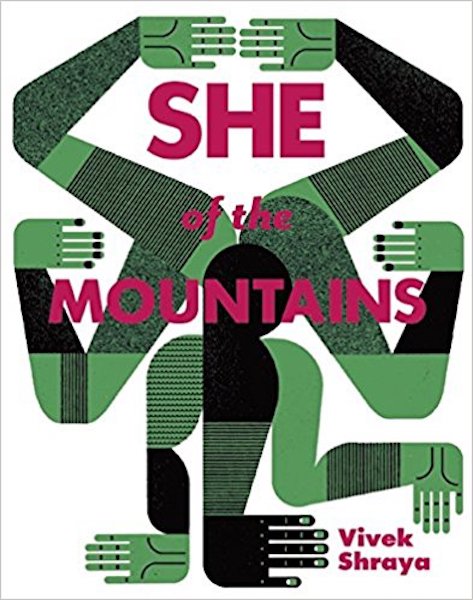
Vivek Shraya is an incredible artist, poet, writer and a million other amazing things. It was hard to pick just one of Shraya’s works for this list, and I highly recommend checking out others, but She of the Mountains was my first exposure to her incredible work. In her own signature way, Shraya weaves creativity into ideas of gender as a construct. Focused on a love story between a boy and his body, this illustrated novel intersperses mythology with profound reflection, beautifully changing the way we navigate gender and sexuality.
The Paths of Marriage by Mala Kumar
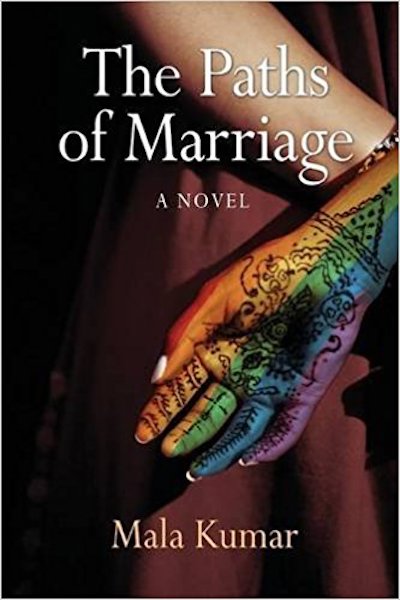
A beautifully crafted novel spanning three generations, The Paths of Marriage is the journey of Lakshmi, Pooja and Deepa. Bound by cultural traditions around arranged marriage her mom and grandmother hold, Deepa must face her fears and come out to her family — but the story goes so much deeper than that. Infused with a relatable immigrant experience and an empowering look at complex female characters, The Paths of Marriage is truly a tale of love and family — surely, one of those books I wish 16-year-old me had.
Love Bi The Way by Bhaavna Arora
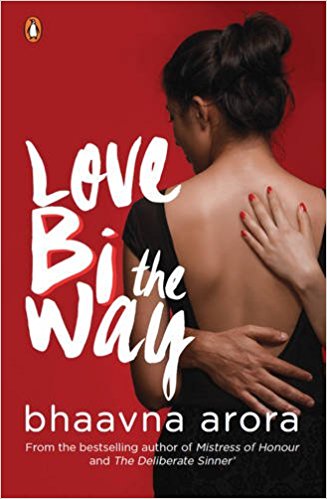
One of the few books on this list that portrays a bisexual South Asian character, Love Bi The Way is a classic opposites-attract kind of story. Rihana, an artist and carefree spirit, and Zara, a business woman who is careful and methodic, build the kind of friendship that is born of two people who have been through their share of dysfunction and pain — one that leads to love. The story becomes more complex when the men in their lives infuse more turmoil and love into their journeys.
The Devourers by Indra Das
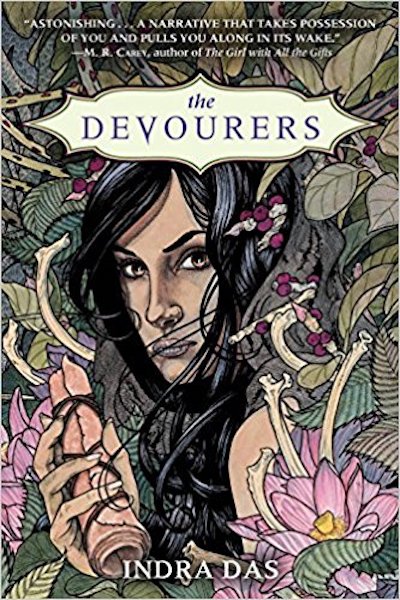
A fantasy thriller that encompasses history, religion, gender, race, species and more, The Devourers is an addictive tale centered around Alok. When he hears the tale of a stranger, one that took place centuries earlier, Alok (and the reader) becomes more and more engrossed in a tale of complex characters. With vivid and compelling storytelling, Das creates a world where man and beast, murder and sex, myth and reality exist side by side.
Valmiki’s Daughter by Shani Mootoo

Valmiki’s Daughter is a beautiful tale of a Trinidadian father and daughter, both struggling with their respective sexual identities. A beautifully woven tale about the courage to be one’s self in a patriarchal society, Mootoo is incredibly apt at transporting us to another place with details that make you almost able to feel, see, hear and touch the world of the characters. More than that, the relationships of Viveka and her father, and the parallel natures of their journeys, make for a heartwarming and hard-to-put-down story.
Kari by Amruta Patil
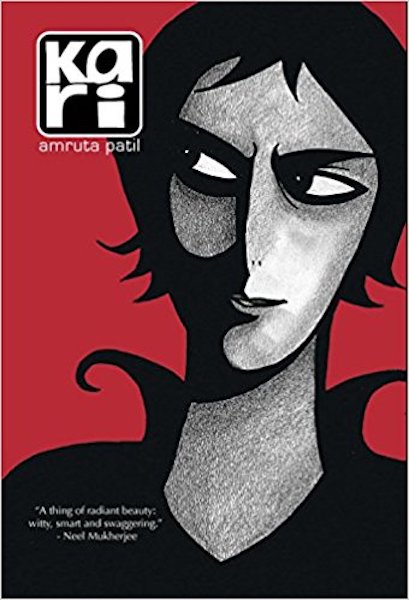
Kari is a gripping tale that goes beyond it’s namesake main character. Taking place after Kari and Ruth literally take a plunge together, but survive, what begins is a nuanced exploration of the love that bound them as well as the city that led them to one another. Kari reads like a love letter to India, to the Smog City, and to the kind of love that is not lost. With nuanced expressions of finding the joy and life and a path of interesting characters Kari meets along the way, this graphic novel is one that is best revisited over and over again.
A Truth about Me: A Hijra Story by A. Revathi
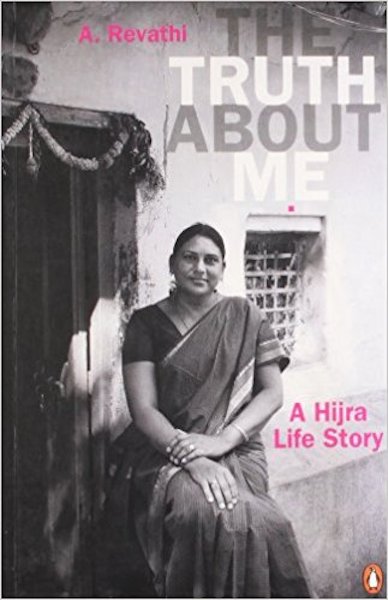
One of the only hijra memoirs to come out of India, this book is a firsthand account of what it’s like to live as part of the country’s hijra community. A. Revathi talks extensively about her journey as a trans woman, from her relationship with her body to running away to live in a hijra house. Now recognized as India’s third gender, hijras have a complicated place in the minds of our people—at once both worshipped and ridiculed. A. Revathi’s story offers a glimpse into this marginalization. This book is moving, and A. Revathi is a strong woman, one who has gone on to become one of India’s leading trans activists. She followed A Truth about Me with A Life in Trans Activism, telling the story of her NGO, which works with people of all genders and sexualities, and sharing her experiences within a community full of courage and resilience.
Moving Truth(s): Queer and Transgender Desi Writings on Family
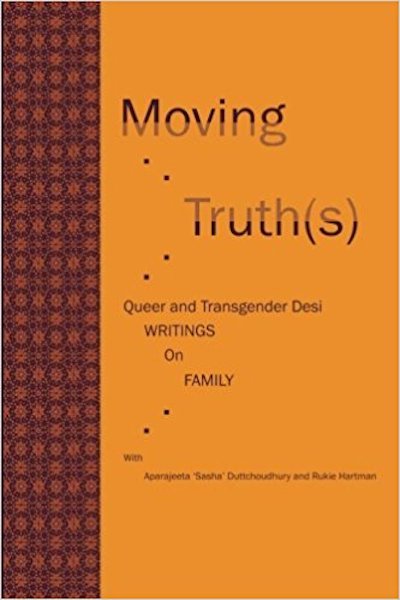
As an anthology, Moving Truths accomplishes its aim to capture an array of diverse voices and experiences. I came across this book around the time I was coming out, and it served as a painful yet cathartic reminder that being LGBTQ and South Asian is sometimes difficult and sometimes beautiful, but always possible. In small snippets, we hear from a variety of people about their experiences with parents and family, weighing culture and tradition with the strength of accepting one’s self.
Out! Stories from the New Queer India, edited by Minal Hajratwala

With 30 compelling and wide-ranging stories from all facets of the LGBTQ communities in India, this anthology was the first of its kind to come out. After Section 377 (the Indian law outlawing same-sex relations) was overturned in 2009, this book was released in 2012, an expression of the optimism and progress that felt so inevitable in the country. The law was later reinstated, and is still being fought in court today. But this anthology — the first book I ever owned that had both the words queer and India on them — is like a time capsule, a diary of siblings and friends sharing the message of holding our cultural histories and love in the same heart with the hope that our country will one day see us the way we see ourselves.
AIDS Sutra: Untold Stories from India
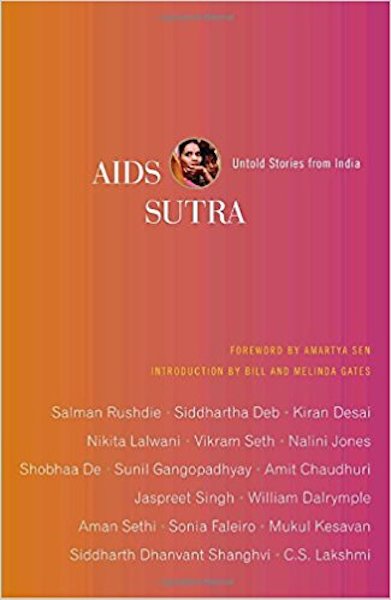
Featuring stories told by well-known authors like Salman Rushdie and Kiran Desai, this anthology explores the untold tales of people living with HIV across India. From the transgender community to sex workers, the stories compiled here are ones rarely ever talked about, and opens a dynamic lens into sex, sexuality, and gender that is a part and parcel of what makes India so complex and yet often silenced.
Be sure to check out other South Asian queer books that have been written about here at Autostraddle: Babyji by Abha Dawesar, Bodymap by Leah Lakshmi Piepzna-Samarasinha, Landing by Emma Donoghue and The Stars Change by Mary Anne Mohanraj.
The realm of South Asian LGBTQ books and novels is constantly expanding beyond the ones named above! Do you have any faves we didn’t mention? Share in the comments below!
Refund Equality Act Aims to Recover Same-Sex Couples’ Tax Benefits Denied by DOMA
Sometimes going back in the past to right a wrong is hard. Nevertheless, in July, Sen. Elizabeth Warren, backed by 69 of her Congressional colleagues in both houses, introduced The Refund Equality Act in Congress. This legislation would ensure that legally-married same-sex couples – who, until the U.S. Supreme Court’s 2013 Windsor decision, were barred from filing federal taxes jointly – are permitted to file amended tax returns back to the date of their marriage.
“For nearly a decade, legally married same-sex couples had to file their taxes as single persons, often paying more taxes than they would owe if they could file as married,” Senator Warren said in a statement. “This bill is a simple fix to allow same-sex couples to claim the tax refunds they earned but were denied because of who they love.”
After Windsor, the Internal Revenue Service published guidance that clarified the IRS’s recognition of same-sex marriages, and stated that married same-sex couples could amend previously-filed tax returns to claim refunds or credits due as a result of corrected marital status. It’s one more part of the groundbreaking legacy that Edie Windsor, who passed away yesterday, leaves the LGBT community. Without a legislative fix, same-sex couples who were married in jurisdictions that recognized same-sex marriage before Windsor – including Massachusetts, Connecticut, California, Iowa, New Hampshire, Vermont, and Washington, D.C. – are currently unable to claim refunds for certain years that they were legally married.
For some couples, the Refund Equality Act could make a big difference. Since Massachusetts legalized same-sex marriage in 2004, for example, couples married in the state would be able to claim credits for taxes paid over the course of nine years. The Joint Committee on Taxation estimates that the Refund Equality Act would return $67 million to taxpayers whose marriages were systematically discriminated against.
For some same-sex couples, like Lujza Nehrebeczky and her wife Joy Hayes, the legislation would be not only an extension of this validation, but a life-altering economic advantage. The new legislation would probably not apply to Nehrebeczky, because although they married in a state that recognized it at the time (Connecticut), their state of residence was and still is Kentucky, which did not. They were eventually able to do the currently allowed three years of backfiling.
“If the new law were available for us regardless of our state of residence, we would definitely take advantage of it,” Nehrebeczky said. “If we could have filed jointly, it would have been a big tax advantage for us.” For 8 years, Nehrebeczky was on a student visa, and her wife had to support her financially and co-sign her student loans, for which she received no tax deductions because she could not claim Lujza as a dependent as she should have. “When we were eventually able to file back taxes jointly, we got a large enough refund for a downpayment on our first home —11 years into our relationship. For us, being able to file joint back taxes meant significant financial relief and security.”
However, some same-sex couples would not benefit from such legislation, at least financially. Gautam Raghavan, President Obama’s former LGBT liaison, married his partner in DC in 2010.
“This is fantastic legislation,” Raghavan told Autostraddle upon learning about the Act. “In a lot of ways, there are certain benefits to filing as married jointly for federal taxes. For us, we could’ve amended our returns after the fact, but didn’t because it wouldn’t have made a significant difference.”
Because of this, Raghavan said, he told his husband there was almost this desire to keep the legacy of discrimination — and painful years of filing multiple taxes—on the record. But he also notes the lesser seen validation aspect of such legislation.
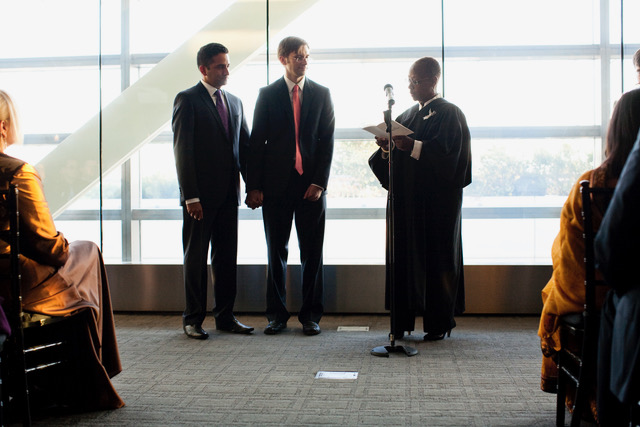
Gautam Raghavan and his husband at their wedding. (Photo courtesy: Gautam Raghavan)
So four years after DOMA was overturned, in the face of a bill like this, has the long-standing view of marriage as an institution based in economic alliance changed? Raghavan seems to think not.
“One of the most compelling cases for marriage equality, and quite frankly civil unions, was that there were a lot of lower-income same-sex couples raising kids around this country that need the economic protection of marriage or having their relationship legitimized in the eyes of government,” he said. “I don’t necessarily see a diminished interest in the economic interests of marriage, I just think that specifically around this issue, we’re not used to thinking about what we owe society, we’re more sort of framed to think of what we were denied for many years.”
“Within and among same-sex couples the framing of marriage for folks like us when couples, where it wasn’t recognized, being denied federal benefits, was not advocacy-based but rights-based. It was about economic benefits like social security, or inheritance, or families, etc. For folks like us, we’ve sort of had this framed as we’ve been denied about 1100 benefits of marriage without anyone really talking about economic responsibilities that come with marriage. Those benefits exist for a reason because in theory, you’re creating a family and economic structure that’s benefiting society generally.”
Maybe marriage for same-sex couple is a lot of both. As Raghavan points out, The Williams Institute estimates that 35% of the LGBT population lives in the South, many with kids and many without state and local protections. The benefits of a federally recognized same-sex marriage in these areas, including health insurance, immigration status, and more, could and has meant better circumstances.
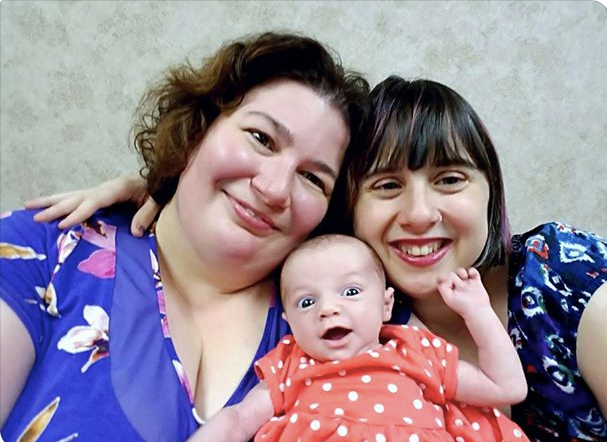
Lujza and Joy with their daughter. (Photo courtesy: Lujza Nehrebeczky)
For Nehrebeczky, the intangible benefits of getting recognition of her then eight-year commitment to Joy through extreme financial and legal hardship was essential to the ability to get married. And in terms of legal benefits, Nehrebeczky points out that they didn’t have many at the time — DOMA being overturned years later afforded them federal protections that simply didn’t exist before, including immigration as well as parental rights. This is the only time Nehrebeczky feels like federal protections don’t apply equally to heterosexual and same-sex couples.
“For example, in order for my wife’s name to be noted on our daughter’s birth certificate as the second parent, we had to provide our marriage certificate and proof from our fertility clinic that we used an anonymous sperm donor. In the case of opposite-sex married couples, the husband is automatically put on the birth certificate, even if the hospital is aware that a sperm donor was used. Even when my wife’s name will be on our daughter’s birth certificate, this does not guarantee that she will be recognized as a full legal parent in other states and countries; for that, we will need a second-parent adoption.”
As for now, The Refund Equality Act has been introduced into Congressional committee, and still has a ways to go before it may or may not come to a vote.
FRIDAY OPEN THREAD: It’s The Last Weekend of Summer, We Did It!
Happy Friday, y’all! So, we’re almost at the weekend and I couldn’t be more thankful. I also turned a ripe 28 years old yesterday, and it was a fantastic one!
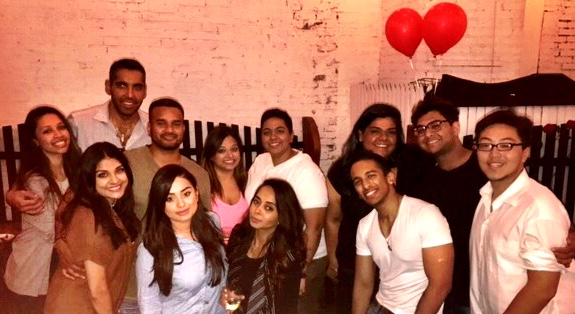
Me and my wonderful family and friends last night.
Birthdays always feel like a mixed bag. I look forward to reflecting on the past year and it’s one of the rare times I am able to acknowledge personal growth. But in the past, I’ve also had really high expectations for what the actual day should be like, and I felt like this year was the first time I was able to take that down a notch and treat it like any other day — it made the fact that I had the day off from work and that my closest friends and family could come celebrate with me seem that much sweeter.
This week I’ve been thinking a lot about getting older and (maybe) wiser and what that means in the grander scheme of adulting and forging new families and maintaining friendships across oceans and eons. In a world where Facebook birthday wishes suffice, I felt blessed for every birthday hug and phone call and text I got. I truly believe this was the first time I felt like I was seen, heard, and held space for and I am incredibly grateful.
I also think as I get older that my birthday cake requirements are slowly returning to childhood needs. Like, why can’t I just have a character cake with normal butter cream frosting and a simple ‘Happy Birthday Priya’ written on it in icing?! Cakes nowadays are too complicated.
The birthday celebrations continue tonight where I’m reading at Queer Memoir in Brooklyn (so if you’re in NYC, come through!) and a scavenger hunt in Central Park tomorrow followed by The Office trivia night! I’m stoked to be 28, it seems like the most fantastic year yet.
Anyways, I WANT to celebrate another trip around the sun with y’all! Tell me how you celebrate your birthday! Is it no big deal at all or do you go all out? Do you journal about your year and how far you’ve come too?!
Can we also just take a moment to acknowledge that this is our last August weekend? What a crazy summer it’s been! Are you ready for September and fall and pretty leaves and PUMPKIN SPICE EVERYTHING?!!? (I don’t think I am, but alas!)
How To Post A Photo In The Comments:
Find a photo on the web, right click (on a Mac, control+click), hit “Copy Image URL” and then…
code it in to your comment like so:
If you need to upload the photo you love from your computer, try using imgur. To learn more about posting photos, check out Ali’s step-by-step guide.
How To Post A Video In The Comments, Too:
Find a video on YouTube or Vimeo or WHATEVER and click “embed.” Copy that code, paste it, you’re good to go!
“BUTCH”: Photographer Meg Allen On Her Kickass Documentation of an Evolving Community
You’ve probably seen (and loved) pictures from Meg Allen’s “BUTCH” photo series around the internet — a breathtakingly diverse array of masculine-of-center women, trans men, and non-binary folks of all ages, races, professions and body types exuding confidence, comfort and great hair. Allen, who is butch-identified herself, photographed 123 models throughout the San Francisco Bay Area in an aim to “see a body of work on all butch women.”
She started out just wanting to practice doing portraits and putting together a unified body of work. She exhibited the 37 portraits she’d shot at the (now defunct) Lexington Club in San Francisco, and the response led Allen to feel there was more work to do: “I realized that maybe this thing that I thought was for me only was actually something my community really wanted and needed to see.”

Even though she was the photographer, the butch-identified Allen felt doubly seen when viewing her own poster-sized portraits. “It’s similar to how I felt when I went to my first dyke club,” She explained. “I was surrounded by people who were like me and I felt like I had a community for the first time. I felt like I belonged, and not only that, I felt like I was desired.”
“Representation through art is important, because it removes society’s rules, hierarchies and structures,” Allen explained. “An artist creates and asks a viewer to enter an unfamiliar world with different rules and customs and there’s no wrong way to experience what one sees in this dynamic. Art just asks that we look and experience and then see what happens.”
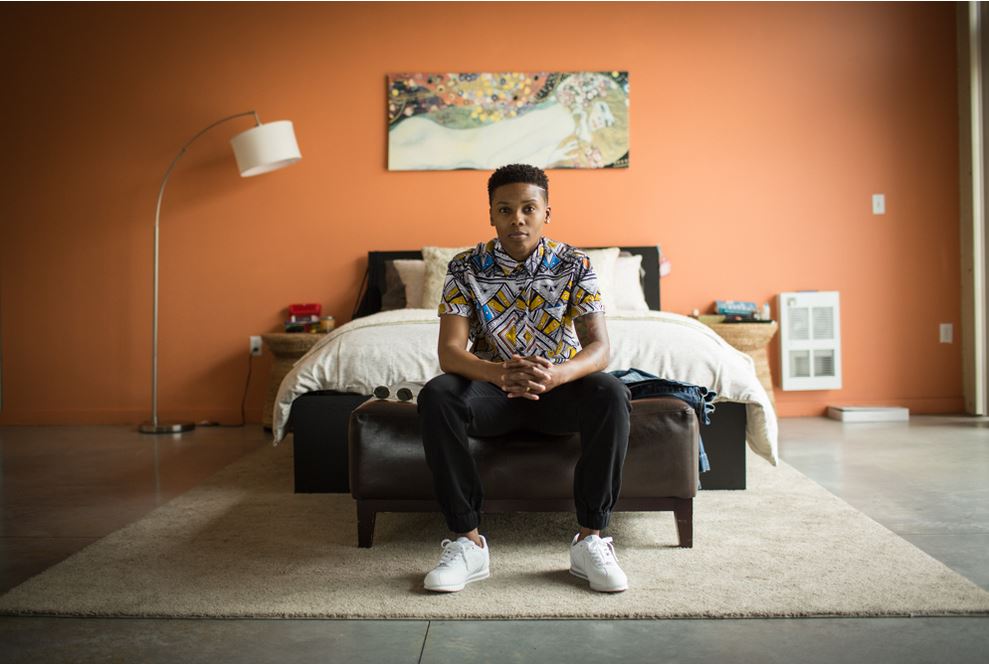
There’ve been a lot of conversations around the idea that butches are “going extinct,” but Allen feels the identity is alive and well — it just takes some different forms now. “In the lesbian community there was a sentiment, and I think there still is, that butches are disappearing. Some say that many butches have transitioned to men or identify as male and there was a sense of loss from the folks I was hearing this from,” she recalled. Allen wanted to know who identified as butch these days and what the “lay of the butch landscape” was.
She ended up photographing mostly female-identified people, but also genderqueer folks and some trans men: “The butch identity overlaps these groups…. butch identity doesn’t conform.”

She continued, “some butches have decided to identify as genderqueer and are completely ambiguous in how they gender their bodies. But butches aren’t disappearing. Non-gender conforming [presentations] have only grown.”
Allen quickly found that “there are a lot of butches out there still. More than ever. And in a larger variety than ever. And that is what my project depicts, in style, body, race and gender non-conformity.”
For Allen, the process of accepting her body has been a long one. “As I got older I learned to love the body I was given, and I did have to LEARN that. As women we are taught to hate our bodies, but why? Why can’t we just be who we are as we are? The answer is in the photographs, butches ARE who they are, and that looks only slightly different for some than it did in the ’50s for example.”
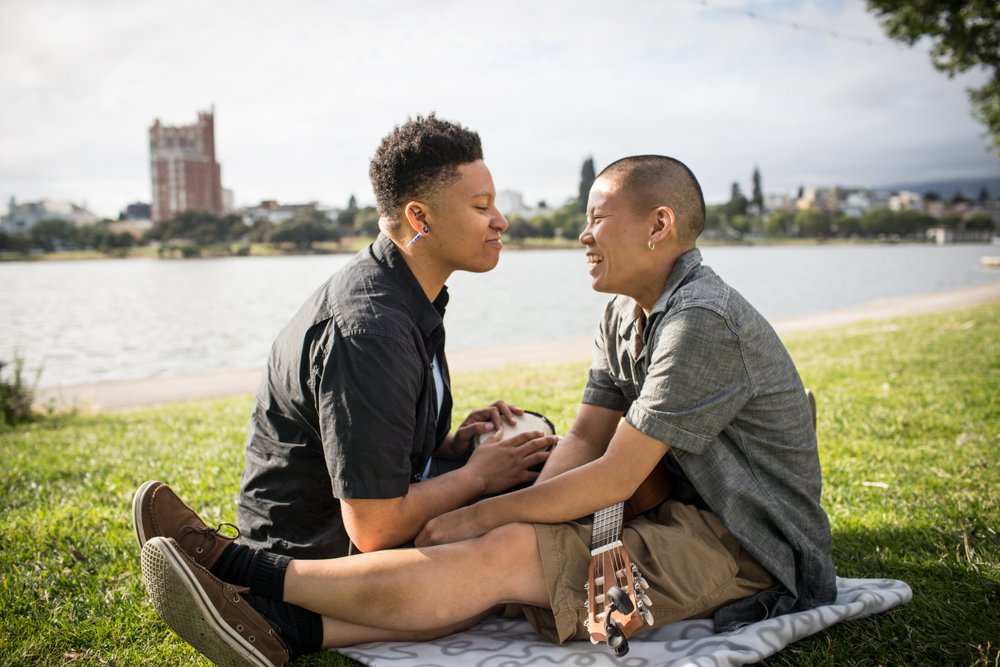
The decision to name the project “BUTCH” came from a specific intention to respect the term from a historical perspective: “I feel like because ‘butch’ is an older and more well-known or even antiquated term, I liked it as an umbrella term. I was looking to update my own idea about what butch means today. It’s a nod to where we came from and who has paved the way in order for the younger generations to be as out and flamboyant as we are now. When I think of butches, I think of the frontier gender-bending queers that had to tolerate a lot of hate and discrimination and exclusion from everything of their time. And I want to infuse meaning to that word to include the current generation of mixed race, mixed gender presentation, and modern culture.”

BUTCH is, at once, a series that challenges norms, strikes the heart, and humanizes the photo subject beyond labels. I asked Allen if this was part of what made the series important.
“In particular, BUTCH is important for two reasons. One, it memorializes a time for queers in the Bay Area that I think is changing rapidly. San Francisco and the Mission District especially used to be a queer haven, but as tech has taken over and bumped prices up it has displaced many queers in the community, especially queers of color. The other reason is that it provides visibility to a community that STILL hardly ever gets represented in mainstream media and advertising. I think the main reason we have finally got some visibility is the internet. We’ve sought each other out and we think our representation is important. And because of all of us finding one another and coming together, the mainstream is finally noticing us as well.”

So what does Allen hope audiences take away from the project?
“For queer viewers I hope they get excited and feel the company of their community. I hope they feel celebrated and seen and inspired to be their best selves and live their lives true to themselves. And I hope that it makes them feel brave and beautiful.
“For straight viewers I hope they just take it all in. This is their chance to stare. I hope it makes them think about gender and their biases as cis and hetero women and men and how the old traditions of gender actually limit them. And I hope they see the beauty that I see in all of these butches, but I won’t hold my breath for that. I think butch is beautiful and that’s enough for me.”
As for Allen, she’s currently working on a variety of projects including working with local artist for a show in Oakland this summer and making her cinematographer debut in film (check out the trailer!). And, she said, there will be more queer work in series form soon. We can’t wait!
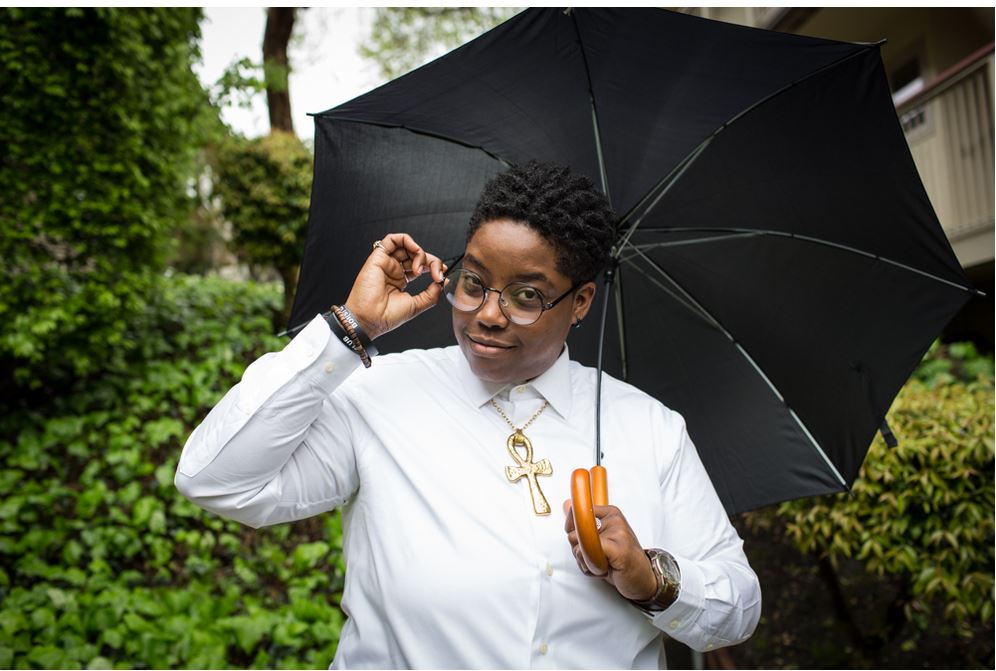
The Terrifying Part of the ACA Repeal That’s Already Affecting Trans and Pregnant People
Continuing his crusade against treating all human beings like human beings, Trump is currently targeting the rights of transgender people and pregnant people. The administration plans to roll back sweeping federal nondiscrimination provisions enacted under the Affordable Care Act (ACA) that protect transgender people and pregnant people.
Everything happening today is overwhelming, but let’s hold one another and try to understand the many layers of what’s going on and what the implications are.
First, let’s set the scene: This morning, Trump signed an executive order on “religious liberty.” Or, as Rachel put it, “not in the sense of actual religious liberty, but in the vein of the Religious Freedom Restoration Acts that empower people and organizations to deny access and services to LGBT people and others.”
Also today, the House is set to vote on a rushed version of the Republicans’ health care bill to replace Obamacare. Not only does Trumpcare 2.0 weaken the definition of pre-existing conditions and raise premiums, the bill will reportedly also defund Planned Parenthood, meaning 400,000 women will lose access to healthcare—in addition to the estimated 24 million that would lose health coverage under the first version of Trumpcare. The bill is so bad, apparently, that Congress has exempted itself from the law’s provisions.
There’s one more thing, though. On Tuesday, the Department of Justice filed a remand and stay regarding “will pause ongoing litigation in a conservative Texas federal district court that had temporarily blocked the Section 1557 regulations and send the regulations back to the U.S. Department of Health and Human Services (HHS) — presumably to gut them. DOJ officials in March decided not to challenge District Court Judge Reed O’Connor’s injunction, which will remain in place while the regulations are remanded back to HHS.”
According to the Health & Human Services website, “Section 1557 makes it unlawful for any health care provider that receives funding from the Federal government to refuse to treat an individual – or to otherwise discriminate against the individual – based on race, color, national origin, sex, age or disability. Section 1557 imposes similar requirements on health insurance issuers that receive federal financial assistance.”
According to Rewire, “that means even religious and religiously affiliated providers that accept money from the federal government can’t deny patients health care or health coverage. If they do, Section 1557 provides a legal vehicle to sue for, say, people seeking sterilization, those seeking abortion care, or transgender patients seeking any health-care services.”
To simplify what this all means:
https://twitter.com/EmilyGorcenski/status/859544158964391936
https://twitter.com/EmilyGorcenski/status/859544370093015040
https://twitter.com/EmilyGorcenski/status/859545106293981184
In a statement, National Center for Transgender Equality Executive Director Mara Keisling said, “The Section 1557 regulation has been literally life-saving for transgender people all across the country, who are routinely turned away from emergency rooms and doctors’ offices and refused coverage for critical medical care. Now, the Trump administration is going after transgender people yet again and trying to take away these basic protections.”
Transgender people face systemic discrimination within the healthcare system, and the impact of condoning outright refusals to provide care perpetuates what is already a minefield of discrimination for transgender people seeking to access care. A community-wide disengagement from the health care system results in dire health outcomes for transgender people, according to TLDEF:
“Rather than enduring abuse and poor treatment, transgender people often simply do without health care. The situation is made worse because in many ways, transgender people have a greater-than-average need to access health care. Transition-related hormone treatments and surgical procedures require partnership with a trustworthy healthcare provider. The alarming rate of HIV infection in parts of the transgender community similarly points to a heightened need for transgender people to access health care without fear of discrimination and poor treatment.”
What’s more is that according to GLAAD, “With transgender people living in poverty at 4 times the national average, a staggering 19% of transgender people report lacking any form of health insurance, including Medicaid.”
As the House debates its repeal of Obamacare, with opponents reading letters of opposition from groups like the American Medical Association and citing statistics of the deplorable impact of this new bill, it’s hard not to crumble under the weight of what might happen to me, my partner, my family, and scores of people I know. But really, Trump’s position in office has already, and will continue to unequivocally impact trans and gender nonconforming people, women, the LGBTQ community, people of color, and the working class.
FRIDAY OPEN THREAD: To Homecomings and New Beginnings
Knock, knock! Who’s there? It’s me, Friday, ya silly!
We’ve made it through another week and it’s time to rejoice — especially because, hi! I’m new here! My name is Priya and I’m one of Autostraddle’s newest staff writers! Thanks to the amazing team and community (you guys), I’ve been full of queer-tastic feels all week.
This week was extra special, from my first piece going up on Monday (yay!), to having dinner with a friend, and from dying of laughter while watching India’s first Netflix original to brainstorming new creative projects on the side. To cap it all, I flew from NYC to Carlsbad, California yesterday (and I survived a LOT of turbulence! and Delta gave us a free “meal!” What!) to attend a work thing. And while the prospect of working extra hard into the weekend is daunting, being just south of L.A. means I get to see my parents for a couple of days.
I guess it’s a homecoming of sorts, especially the not-being-stared-at-for-having-a-California-ID thing. Being back in my home state is nicely overdue (sometimes, you really need to get away from New York) — and also, I kind of forgot what sunshine was like. This week I’ve been thinking about chosen and birth families, the burden of representation, the privilege of travel, and how to refocus my energies away from stressful, draining, or stagnant ventures towards things that inspire, sustain, and captivate me. Something about being here, talking to all of you, makes me think I might be onto something.
Between binge watching The Handmaid’s Tale and traveling, it’s been a heavy week, to say the least. I’m looking forward to a little poolside reading (*ahem* napping *ahem) time at this super nice resort a la pseudo-vacay! What have you all been up to this week? Did you snooze that morning alarm a few extra times? How are your pets doing? Do you know what causes turbulence?
Come in, say hello, and share a fun fact about yourself if you feel like (maybe an old AIM screenname)! I want to get to know each and every one of you — cue group hug! :)
How To Post A Photo In The Comments:
Find a photo on the web, right click (on a Mac, control+click), hit “Copy Image URL” and then…
code it in to your comment like so:
If you need to upload the photo you love from your computer, try using imgur. To learn more about posting photos, check out Ali’s step-by-step guide.
How To Post A Video In The Comments, Too:
Find a video on YouTube or Vimeo or WHATEVER and click “embed.” Copy that code, paste it, you’re good to go!
Searching for My Own Queerness in Bollywood
Between my parents’ house in LA and my apartment in NYC, I have a collection of at least 50 Bollywood film posters buried in my closets (pun intended). I still have heavy, glass-framed posters of Kuch Kuch Hota Hai and Dilwale Dulhania Le Jayenge, classic romance-drama films of the 90s, hanging in my childhood bedroom. My obsession with Bollywood goes as far back as I can remember (and then probably before that, too.)
Looking back, I chalk up this obsession to a plight that plagues me more and more as an adult — the unquenchable thirst of wanting to see someone like me on television, in movie theaters, and on the pages of novels that line my bookshelves. When I was younger, this meant I wanted to see a South Asian woman who found love and acceptance against all odds. Later, as a young adult coming out as queer, this meant yearning for so much more: love and acceptance, sure, but also validation of both my desires as related to people of all genders and my choice to don short hair and wear men’s clothes.
All of which is to say: I needed to know it was possible to be a South Asian queer woman who could find love and have a “happy” ending.
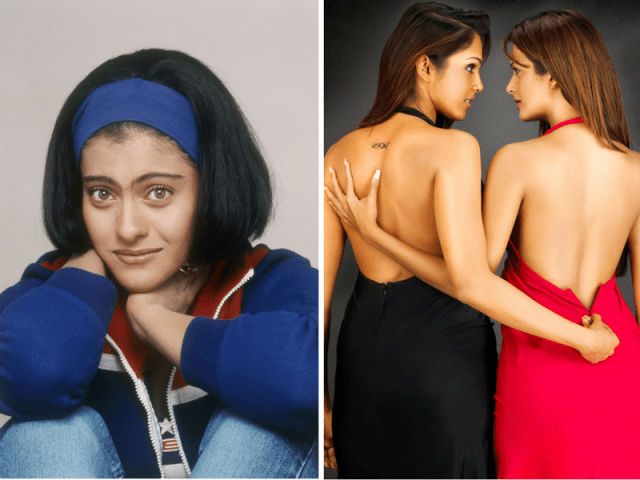
Left: Kajol as tomboyish Anjali in Kuch Kuch Hota Hai, Right: Isha Koppikar and Amrita Arora in Girlfriend
What I learned from this cinematic medium that taught me to be fluent in Hindi just about the same time I learned English was that someday, against all odds, my knight in shining armor would win the approval of my family and marry me in a multi-day, multi-event big, fat, Indian wedding. As I grew into my intersectional identities, I thought my queerness meant this would all vanish, that somehow my Bollywood ties to my parents’ roots would be severed by the deviance of my desires. Instead, part of accepting my identity as both queer and South Asian has meant revisiting Bollywood in search of female presences that both entice and inspire me. Unfortunately, Bollywood has left much to be desired in this regard.
In the ’90s, Hindi cinema began to scratch the surface of LGBTQ depiction with caricature-like portrayals of gay male characters who were effeminate (and therefore “less” than the cis-hetero men who sidelined them) and/or hypersexual (striking fear in those around him that they would fall prey to his frivolous ways). These gay men were, therefore, misfits who became the butt of all jokes. From roles as the only one in a group of friends who’s worse at sports than his “manlier” friend (like in Pyaar Kiya Toh Darna Kya), to design-privy fashion icons (as in Fashion), and single, older, hypersexual males like Boman Irani in Dostana and Rishi Kapoor in Student of the Year, Bollywood depictions have made gay men the epitome of stereotypes. Through it all, these characters most often never openly identify as gay, nor are they portrayed with any other layer of identity (or humanity).
Despite India’s own troubled past with the criminalization of same-sex relations (first de-criminalizing and then re-criminalizing colonial-era Section 377) these terrible depictions easily became Bollywood’s flag of visibility for a community that not only has more depth in individual identities but that span more identities than just cis gay men.
On my own journey, I discovered many loves, in the forms of both female characters I resonated with, as well as those whom I wanted to emulate.
The first of these was Kajol, star of Kuch Kuch Hota Hai and countless other classic romance-dramas of the ’90s. In KKHH in particular, Kajol portrays Anjali (second only to Rahul as the most overused name in Bollywood), a tomboy-ish short-haired woman who loves basketball and is, essentially “one of the guys.” This trope plagues her when she falls for her best friend Rahul, when he is instead in love with Tina, the short dress-wearing, beautiful girl on campus. Anjali even goes so far as to try wearing makeup and dresses to fit in with girls like Tina, but is mocked endlessly. I related much to Anjali, basketball to non-girly clothes — so much so that for a period of time, I thought I too could blossom into a more femme (and therefore more desirable) woman eight years after college and finally end up with my first love.
Later came Fire, a film I discovered years after its release. The two female leads find love with one another after differences and abuse from their husbands (who are siblings). Though groundbreaking in its depiction of love between two women, which I found immense resonance with, it was also a story that showed this love as the byproduct of misogyny and failed straight relationships. This wasn’t my story, and though its desire lit a fire in me, it wasn’t something I could look up to, or even point to within my community as a means of understanding my lifestyle.
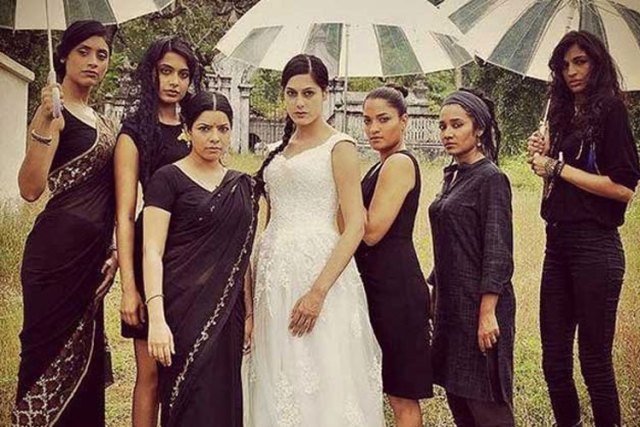
Angry Indian Goddesses
Then came Girlfriend, a film that was open about its lesbian angle. In it, a love triangle develops between two female friends, Tanya and Sapna, and Sapna’s boyfriend. Tanya is shown as jealous and overprotective of Sapna, to the point of obsession and violence. Eventually, her psychosis marks her end, showing me, and lady-loving Indian girls like me that lesbians were literally crazy.
Bollywood has since moved the needle, albeit a little bit. First, there is a subjective understanding of feminism being a concept, and the mainstream success of films like Queen show this. Showing the self-reflective journey of a woman whose marriage falls through, Kangna Ranaut displays the kind of independence that I strive to embody by being as out (and unreliant on men) as I am.
There have also been progressions with male gay depictions, with strong, multi-faceted characters in Kapoor and Sons and Aligarh. Where the first dealt with a gay man’s very real and internalized struggle about coming out to his family, the second showed the true story of a gay professor in the city of Aligarh who was outed and ostracized thereafter. Both depict these characters as people with more to them than just their same-gender attractions, eliciting relatable humanistic struggles around conformity, and the privilege (and burden) of being out.
And finally, in 2015, the movie Angry Indian Goddesses was as close as ten-year-old me could’ve gotten on the journey of self-acceptance. Upon the premise of reuniting for a bachelorette party, seven women gather in Mumbai and find out that two of them, Freida and Nargis, are the ones getting married. The movie touches upon issues of gender equality and the treatment of women in a patriarchal society, while also weaving strong female characters, the importance of female bonding, and a female-female relationship that is treated with dignity and grace. In the end, this relationship is not what defines either the movie or its characters —and though neither had hair as short as mine, I reveled in the completeness and relatableness of both the women-loving female characters and the straight ones.
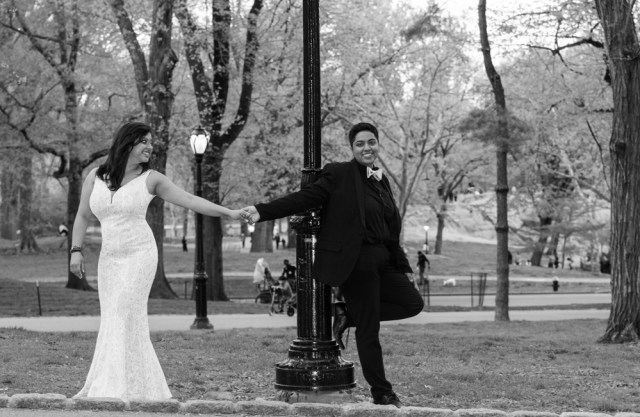
Priya and her partner in Central Park, NYC (Photo Credit: Grishma Patel)
I don’t put up as many Bollywood posters on my wall as I used to; my apartment walls instead adorned with pictures of my partner and I as well as her acrylic paintings of everything from landscapes to peacocks to beautiful women. My life now consists of creating and capturing real life narratives forward for young Indian girls like me who still seek holistic portrayals of queer South Asian women. I believe that for my family and friends, the simple act of being out is resistance in and of itself.